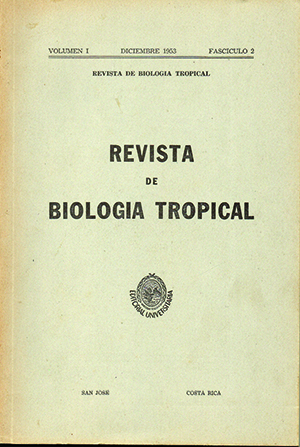Abstract
This paper presents some aspects rdating the cutaneous activity of leishmaniasis in Costa Rica.
The A. considers in the first place the bahavior of the antigens of Leishmania brasiliensís and L. enriettii with relation to cutaneom sensitivity. He made a total of 158 intradermal-reactions using both antigenes in order to compare the antigenic re!ationship between the two species of the genus Leishmania. He found that the cutaneous activity was manifested with equal sensitivity to both antigens.
The allergic reaction was greater with the Leishmania brasiliensis antigen in 37 per cent of the cases. The cutaneous sensitivity was equal in 61 per cent of the cases and only 2 per cent the allergic response was higher for the Leishmania enriettii antigen.
The A. also noted among the local reactions that all the patients treated with the Leishmania brasiliensis antigen cxperienced a greater itching than those treated with the Leishmania enriettii antigen.
The positivity to the heterologous antigen showd that the Leishmania enriettii presents common antigens with the L. brasiliensis and that these are responsible for the crossed-reactions in the cases of the leishmaniasis of the skin. These are same facts that have been observe in the other species of leishmanias which are parasitic to man.
Another point considered is the early beginning and the duration of the skin sensitivity. He found in 20 patientes with lesions of 8 days to one month duration, that 89 per cent showed a positive reaction.
In two cases in which the innoculation was done experimentaly with Leíshmanía brasiliensis, he found that the beginning of the cutaneous sensitivity is independent of the incubation period and the time of evolution and is related only to the allergic background of each particular person.
The A. observed also that in Costa Rica, as in other countries in America, the sensitivity which is acquired with leishmaniasis persists for the rest of the life and is manifested with a positive skin-reaction regardless of the last period of activity.
He made intradermal-reactions in patients with cutaneous and muco-cutaneous lesions and found that the most positive reactions were given by patients with muco-cutaneous lesions.
The A. made skin-reactions in 13 patients with skin diseases of other etiology without obtaining positive reactions. In 131 patients without history of leishmaniasis but living in endemic areas he found 3 who gave positive skin-reactions.
The A. thinks, as Pessoa (23), that those persons had a sub-clinical infection which did not give a skin evidence but an allergic one.
The A. found a sensitivity of 96 per cent in a group of 71 patients whose clinical diagnosis was laishmaniasis. He observed false negative reactions in patients with viral diseases such as measles, and probably yellow fever, varicela and mumps.
Finaly, he studied the cutaneous reactivity in the geographical regio n of Moravia de Chirripo and he found an allergic index of 37,74 per cent. Most of the reactors were from Pacuare; in this place the index was as high as 44 per cent. This is the most important endemic area in Moravia.


